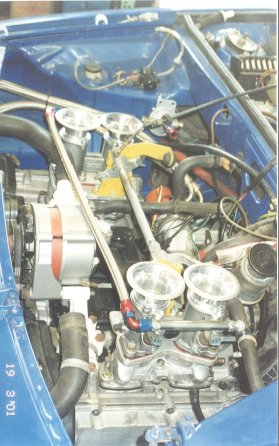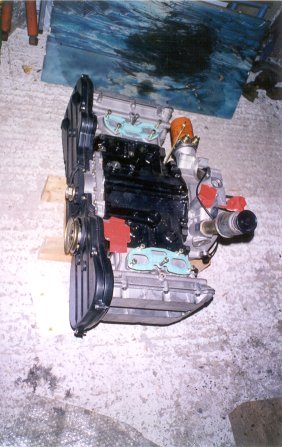 Welcome to an Alfa Nuts' Heaven - supposing you like that sort of thing, of
course.... Welcome to an Alfa Nuts' Heaven - supposing you like that sort of thing, of
course....
What am I doing? Sticking an Alfa Romeo Alfa 33 16 valve engine into an AlfaSud Sprint.
This site is currently being updated to reflect more work performed on the car - the date
of this message is 26th July 2001. I hope to have the majority of the updates finished by
the 2nd August.
This Web site features my
own car, which I have modified, cossetted, slaved over, spent money on, and even banged
into things.
Most people will be tuning in for information on two aspects, that is tuning of the 8V
Alfa Boxer engine, and how to fit a 16v Alfa 33 engine into a Sud or Sprint.
My Car
The original car is an Alfa Sprint 1.5 twin carburettor model, with the later plastic
bodykit but with the earlier Alfasud suspension and braking system.
I had previously installed a 1.5 twin carb engine that I had modified and built myself,
which gave around 108bhp. It was good, but modern middle of the range hatchbacks produce
the same or better power, so what would have been a fast car twenty years ago is merely
quick these days. Any of the current 'hot' hatches left the Sprint standing, figuratively.
So I wanted more power was the conclusion I came to. The Alfa Boxer is a tunable engine,
and mine had been tuned to produce at least 13bhp more than standard, using home modified
standard parts, without even resorting to a cam swap. I considered that a tuned 1.7 8v
twin carburettor engine, with hotter cams and quality porting and larger valves, and a
compression hike would be a good start.
Things start to go
pear shaped
I was due to come back to
the UK for a month, and I wanted to try and get everything arranged for when I was back.
Unfortunately, the first thing that any of the tuners said was "well, what is the
condition of the engine you want modifying?"
Well, of course I had to tell them that I didn't have one and that I would need to get
hold of one. They proceeded to tell me that to start with, once I'd paid for the engine, I
would have to recondition it before I could start tuning it. The donor engine plus the
reconditioning was coming out at over £1500 plus VAT, and I hadn't even got near tuning
it yet!
So, on top of that I would then have to consider a pair of cams, larger valves, porting
and bigger carburettors, which together total over £1000 plus VAT. So that's £2500 plus
VAT at least. I forgot, plus the rolling road tuning. Oh, and what sort of power could I
expect for that then? "oh, 125bhp, maybe as much as 130bhp". Eh? I didn't hear
that right. 125 to 130 bhp? At the flywheel?
That is well over £100 for every one brake horsepower gained! And to cap it all, with the
effect of the hot cams, and the bigger carbs, it would not idle very nicely, be a pig in
traffic, and use fuel at a disastrous rate. It was mentioned that aftermarket injection
would smooth out the engine and help it to produce the power, but that is spending even
more money to just make a compromise slightly better, it seemed to me. It is not that I am
against fitting the injection, it just didn't seem to be worth fitting it in that case.
The final nail in the coffin for the tuned 8v was that no-one would be able to produce an
engine to that spec in the time frame available. So the idea was binned.
But all is not lost! (especially if, like me, you have a fundamental lack of sense)
Then someone mentioned that the 16v engine, in standard guise produces upwards of 135 bhp
dependant on spec, with tons more midrange torque. Why not get a reconditioned one of
those, they fit ok because he'd seen one somewhere... etc
Well, the planned 8v engine transplant mutated into a 16v, and then I started to
reconsider those aftermarket injection systems, and..... well, it's just easier if you
read on.
One other thing that came out of this was the need for the later suspension, but I had
other reasons for wanting that anyway so I was sort of looking for an excuse to upgrade.
I must make it clear that I have not quite finished this project, and that like this car
this site is under construction. I would welcome any (printable) suggestions as to what to
do to improve this site, and am able to stand a reasonable amount of constructive
criticism.
I will also make a policy of not naming any company or persons that I have had bad
experiences, so you can be happy in the knowlegde that if you are named in here it is for
good reasons.
I do not accept any responsibility whatsoever for any errors or omissions in this site,
nor for any damage, liabilities or accidents that may ensue from the use in any way from
the information therein.
 Summary of the conversion Summary of the conversion
The intention is to install
a 1.7 litre 16 valve engine from the series 3 Alfa 33 model. The standard injection setup
of the engine is to be discarded, and the engine modified to run on an adapted aftermarket
fuel injection system. The standard ignition system of a mechanical distributor with
electronic ignition packs is also to be discarded, with a fully integrated engine
management system taking over its duties. The management system will also control the
injection system. The way that the modification is to be performed will also allow interim
use of carburettors and a mechanical distributor.
The Sprint fuel system would then be modified to suit the needs of the fuel injection
system.
In addition, the Alfa 33 suspension system, which utilises a radically different braking
system and mildly different suspension parts, is to be installed. All the suspension
components will be transferred across and bolted in, and the brake hydraulic system
modified and adapted to fit. Please refer to the supsension installation page for the
detail differences.
The later Alfa 33 gearbox is to be used, which has slightly longer ratios. In theory this
should be a straightforward swap from one car to the other.
Please note that for the following text, all references of position are relative to
viewing from the rear of the car
16v versus 8v engine -
changes
The 8v engine that is being
compared here is the twin Weber 36IDF or Dell'Orto 36DRLA carburettor type available in
1.3, 1.5 and 1.7 litre capacity versions, in the Alfa Sud, Sprint and 33 models.
No major detail will be presented here, I will just touch on what the significant
differences are, what affects the conversion, and what changes drive the conversion.
Obviously the most dramatic change is that the cylinder heads are all new, with four
valves per cylinder instead of two in the earlier engine. The heads are of twin, overhead
cam type, which operate directly on the valves via hydraulic tappets. The design requires
that each cam has a timing wheel, so there are two rather large cam belt wheels on each
head, with a belt tensioner located of the front of the block on each side. The cams belts
are protected by a large plastic cover.
The heads are deeper than earlier heads, and the cam cover bottom edge lies below the
adjacent block, which means the gravity oil return passages in the block are too high. To
get round this, both the sump pan and the heads are fitted with flanged passages, between
which are installed two flexible metal tubes, which returns excess oil to the sump.
The newer head dictates the use of a different inlet manifold shape, and the manifold
casting is radically different to the carburettor engine manifolds. The manifolds have
bosses for the injector cast into them, and the inner profile of the manifold port is
shaped to direct flow into the bifurcated port of the heads. Passages in the manifolds
allow coolant to flow from the heads into the thermostat housing in a similar fashion to
the carburettor engines. The upper manifold flange is made to accept the butterfly bodies
that are the standard Alfa fitment - these engines were never produced with carburettors.
An induction system comprising a flow metering device and filter and housing assembly is
mounted onto the top of the throttle bodies.
The engine is fueled by an electronic fuel injection system, which reads engine speed and
position from the flywheel via a rear crankcase cover mounted sensor, engine demand by
means of a flowmeter, and engine temperature by means of a water temperature sensor
mounted in one of the inlet manifolds. Fuel is supplied by a high pressure injection pump
mounted under the rear of the car next to the spare wheel well, and a fuel pressure
regulator controls the pressure and returns unwanted fuel to the tank via a high pressure
return line. Most of the fuel lines are made from nylon, with steel fittings and
connectors, plus steel fuel rails mounted on top of the injectors. Fuel is unleaded.
Ignition is either via a mechanical distributor as fitted to the carburettor engines, or
on later varieties a distributor-less system controlled by the Alfa management system.
The exhaust system is larger bore, and the attachment flange to the heads is different
from all 8v versions. In addition, it is a straighter run rearwards, so its shape is
different from those fitted to AlfaSuds and early Sprints.
The engine front crossmember was redesigned to clear the additional bulk of the cam wheels
and covers.
Some series three cars were fitted with power steering and air conditioning, and therefore
a crank pulley with three grooves is fitted to the engine as standard.
The capacity of the engine is nominally 1721cc, and the stated power output is around
136bhp, but different power rating are quoted for the different models fitted with
catalytic converters.
If you have any queries, or have any suggestions as to what would improve
this site, send me an e-mail
|
|



 Welcome to an Alfa Nuts' Heaven - supposing you like that sort of thing, of
course....
Welcome to an Alfa Nuts' Heaven - supposing you like that sort of thing, of
course....